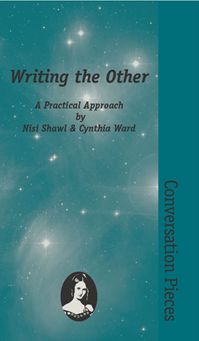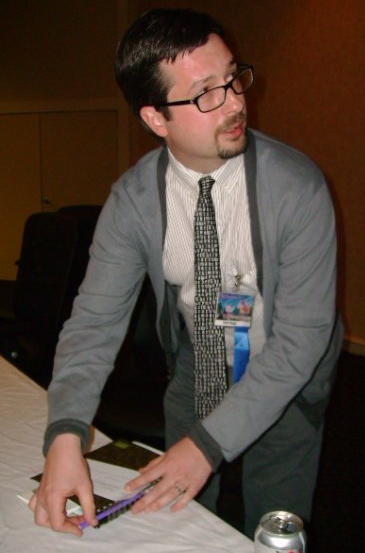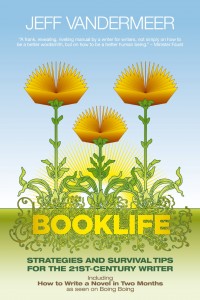
This is writer Nisi Shawl’s last post for Booklifenow, and I hope you’ll join me in thanking her for her great posts, this one included. Nisi is the co-author of Writing the Other, with Cynthia Ward, who will be contributing a last post later this week. I’m very grateful to both of them for such thoughtful and useful words. – Jeff
A subscriber to the Carl Brandon Society list serve asked for specific criticisms of the Spinrave recently published in Asimov’s SF Magazine. That is work. Just reading it is an effort, let alone trying to translate into something resembling sense. Hence my response below to the request for “specific criticism”:
“Okay, I would take the time to analyze the article if someone paid me for it. My rate is $50/hour.
“As a sort of free sample, I’ll say I agree essentially with (another poster to the list serve): consider the source. The source being Norman Spinrad, who not only doesn’t know anything about the subject upon which he bloviates for page upon page, but who seems to be inordinately proud of his ignorance. Norman is like this. My short response: tldr.
“I will also add that his positioning of Mike Resnick, a very good writer, as an African writer, is so insanely disorienting as to induce vomiting. And comparing him to Octavia E. Butler, who never, as far as I am aware, ever claimed to be an African writer, is an action on a par with opening a chest full of tokens and rummaging around blindfolded in it, and pulling one out at random to toss onto the hearth of rhetoric.”
The subscriber requesting explication declined my help. He thought my fee was too high—though another poster advised me to double it—and made do with the numerous other posts available on the subject.
Among them we find N.K. Jemisin, who deals with one specific point. It takes her 500 words, not counting her contributions to the post’s comment threads. Imagine if she had attempted to render the entire Spinrave comprehensible. How many short stories and/or novels of hers would we be doing without while she whacked her way through his thorny densenesses?
My offer stands.
Ante Spinrave, I expected to devote the whole of this final guest post for Booklife to analyzing a panel I recently pulled off at Radcon, an SF convention held in Eastern Washington. The panel was titled “Writing and Racial Identity.” Besides myself the participants were Eileen Gunn, Alma Alexander, and Bobbie Benton-Hull. Here’s the description I gave programming:
“What does your race have to do with what you write? Depending on your race, are certain topics forbidden to you? Obligatory? None of the above? If your race matters, how do you know what it is? By what people see when they look at you, or by what you know of your genetic background? By your cultural upbringing? By what you write?”
We had a grandly civil hour-long discussion about how our racial identities did and did not contribute to what we wrote, did and did not determine what we wrote, about how we dealt with others’ expectations of us as writers based on what they knew and/or assumed about our racial identities, how we constructed those identities for ourselves with our writing and in other ways. I loved that we spoke as equals, according each other and the subject all due and appropriate respect.
Because it is a complex subject, one that deserves careful thought.
One white panelist related a classroom encounter with Faulkner in which her instructor held up this famous white male’s avoidance of a black female character’s interior life as an ideal to emulate; to write some things she has written, the panelist has had to unlearn what she’d been taught. Another spoke movingly of the ethnic and religious distinctions that formed the core of her upbringing in Central Europe. I wondered aloud if my difficulty placing stories with white protagonists was due to editors wanting “more black for their buck;” that felt risky to me, since one of the field’s top editors sat in the audience’s front row, not five feet from my face.
Our fourth panelist had been raised as an American Indian and spent her life knowing absolutely that this was who and what she was. Then she discovered through genetic testing that her biological heritage is a mix European and Sub-Saharan African. No American Indian. She still struggled with integrating this knowledge at the time of the panel, framing her thoughts on her identity as a question, referencing a female character in the movie “Dances with Wolves.”
It was all most interesting to me. Way more interesting than the Spinrave. In my description and in my moderation I had aimed to show that race is an issue that affects writers of all backgrounds, all races, that racial identity is labile, is inflected by more than one sort of information, and in turn has complex and complicating effects on what we say, how we say it, who we say it to….We touched on each of these subjects with a sure touch, though in some instances only a brief one. There’s so much to talk about.
There are so many smart people to include in the discussion. I want to hold this panel again someday soon. Maybe at WisCon? The panel will give its participants and our audience much to think about. And they will think, and do research, and speak carefully. And it will make sense.
 Matt Staggs is a literary publicist and the proprietor of Deep Eight LLC, a boutique publicity agency utilizing the best publicity practices from the worlds of traditional media and evolving social technologies. He has worked in the fields of public relations and journalism for almost a decade. In addition to his work as a publicist, Matt is a book reviewer and writer whose work appears in both print and web publications.
Matt Staggs is a literary publicist and the proprietor of Deep Eight LLC, a boutique publicity agency utilizing the best publicity practices from the worlds of traditional media and evolving social technologies. He has worked in the fields of public relations and journalism for almost a decade. In addition to his work as a publicist, Matt is a book reviewer and writer whose work appears in both print and web publications.
